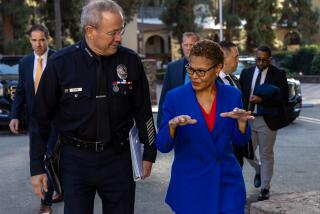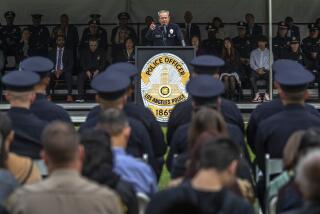LAPD significantly scales back spending for mass protests, civil unrest

Los Angeles police officials have scaled back significantly the cost of a plan to train officers and purchase equipment they say will improve the department’s response to large protests and civil unrest, according to documents released Friday.
The $18.5-million cost of the proposed plan, which the Los Angeles City Council would have to approve on top of the LAPD’s existing budget, is about a quarter of the nearly $67 million the department previously estimated it would need to address a raft of reforms called for in various reports on its handling of demonstrations and unrest after the murder of George Floyd in Minneapolis in May 2020.
The department was unprepared for those protests. Independent and internal reviews of the LAPD’s response found, in the words of one report, a “chaos of command” that led to police officials giving contradictory orders in the streets and officers being equipped with weapons they weren’t adequately trained to use.
The new plan, which was outlined in a report released Friday by the Police Commission, calls for nearly $12.6 million to be spent on training thousands of officers on, among other tactics, the use of rifles that fire hard-foam projectiles to control large crowds. The department is under a federal injunction to provide such training to officers who use those weapons. The earlier proposal had said training would cost $53 million.
About $4.1 million would be earmarked for a new team of intelligence analysts outfitted with updated technology. The equipment would include a computerized system to track the location of officers in chaotic situations and other software that would help the analysts monitor protest activity on social media.
Such intelligence-gathering has been harshly criticized by protesters, who see it as an invasion of people’s privacy that could have a chilling effect on demonstrations.
Millions of dollars would be used to pay for overtime, both to officers receiving training and those who fill patrol shifts while others are being trained.
An additional $900,000 would go toward community relations work, including $560,000 to increase the size of the Los Angeles Police Department’s public engagement team and diversity and inclusion teams.
The civilian Police Commission, which oversees the department, is scheduled to discuss the proposal at a meeting Tuesday. If approved by the panel, whose members were involved in writing it, the funding plan would go to the City Council.
Commissioners, LAPD officials and council leaders responded to requests for comment Friday.
Mayor Eric Garcetti called the plan “a critical step” toward important, necessary reforms.
“Three separate reports on last summer’s demonstrations have sent a clear message: We need to do a better job keeping Angelenos safe when they gather in large numbers to make their voices heard, and those improvements need to happen now,” Garcetti said.
The council could opt to put forward proposals of its own. The reforms in the LAPD’s proposal, however, mirror many of those called for by a team of consultants commissioned by the council to review the LAPD’s handling of last year’s protests.
Activists across the city, many of whom took part in the protests, will probably oppose the LAPD plan. They have called for the police budget to be slashed in favor of spending city funds on social services for residents who are poor, homeless, mentally ill or addicted.
Activists slammed the $67-million reform projection in April as a money grab by the LAPD, and some have said no increase in police funding is appropriate — regardless of whether it’s geared toward reforms.
Melina Abdullah, co-founder of Black Lives Matter Los Angeles and a leader in last year’s protests, said Friday that she rejected the $18.5-million plan, just as she had the $67-million one.
“I don’t think that they should be rewarded for brutalizing protesters, in any amount,” Abdullah said. “Sixty-seven million dollars was too much, and $18.5 million is still too much.”
The new plan is the result of months of work inside the LAPD to determine which of the recommendations in the earlier reports should be prioritized and how to implement them. With city leaders and members of the commission expressing reservations about the $67-million price tag, LAPD officials scrambled to find ways to pursue reforms at a lower cost.
Although the LAPD, like other city agencies, endured belt-tightening last year as fallout from the COVID-19 pandemic depleted city coffers, it has hardly been defunded as critics wanted. After the protests, the City Council voted last year to cut LAPD’s operating budget by $150 million, to $1.71 billion. For the current year, however, the council increased the department’s budget by about 3% to $1.76 billion, which represents a large portion of the city’s overall spending.
At the center of the reform plan is increased and retooled training, which was a focus of the reviews of the Floyd protests.
The new plan calls for a cadre of LAPD officers to receive training on the use of the hard-foam projectiles that is more in-depth than what is currently taught to all officers. In addition to shooting the projectiles, which can cause serious injuries, at stationary targets, the selected officers would learn how to fire the weapons at moving targets, officials have said. Those officers would then be designated to respond to protests.
The department has claimed in lawsuits and elsewhere that officers who seriously wounded protesters during last year’s protests had been aiming the projectiles at other targets and had not intended to hit people.
Training officers on how to use the projectile rifles is required under an injunction issued by a federal judge overseeing a class-action lawsuit against the city and the LAPD. Black Lives Matter Los Angeles and other activist organizations filed the lawsuit after last summer’s protests.
The proposed new training would ostensibly bring it in line with the requirements of that injunction.
Notably, the LAPD’s plan does not seek funding for the creation of a new LAPD bureau for “public order policing.” The report ordered by the City Council had recommended it, but the idea was widely panned, including by some council members.
Gerry Chaleff, a former civil rights attorney who worked for years as an advisor to LAPD chiefs and wrote the council’s report, argued the new bureau would help protect people’s right to protest and ensure the department took its role in facilitating protests seriously. Critics countered that it would require more funding to the LAPD and could be used to surveil and harass organizers.
“Do we actually have to create a new bureau?” asked Councilman Kevin de León at a council hearing on Chaleff’s report and recommendations in March, echoing the skepticism of some of his colleagues.
LAPD officials are expected to present details of the plan to the commission Tuesday.
More to Read
Start your day right
Sign up for Essential California for news, features and recommendations from the L.A. Times and beyond in your inbox six days a week.
You may occasionally receive promotional content from the Los Angeles Times.






